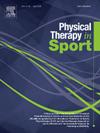评估后备军官训练队学员着陆失误评分系统与单腿深蹲之间的关系
IF 2.2
3区 医学
Q1 REHABILITATION
引用次数: 0
摘要
目的评价着陆失误评分系统(LESS)与单腿深蹲(SLS)在评价后备军官训练团(ROTC)学员神经肌肉控制缺陷中的相关性。设计横断面观察性研究。SettingUniversity体育馆。参与者:56名后备军官训练团成员(年龄:20.16±1.7岁;性别:女性20人,男性36人;高度:68.78±3.32英寸;质量:73.65±12.98 kg;优势肢长;89.83±5.1 cm)完成3次起跳和5次SLS试验。使用PhysiMax无标记运动捕捉记录跳跃着陆和SLS,并根据二分类量表自动分级额、矢状面误差。结果LESS评分的平均误差为5.36±2.93,SLS评分的平均误差为3.93±1.03(左)和4.30±1.73(右)。在LESS和SLS误差之间没有发现显著的关联,包括膝关节内侧在额位面或任何矢状面位移误差。结论由于任务差异,LESS和SLS可能捕获了神经肌肉控制的不同方面。临床医生应利用这两种筛查方法来识别高危运动。本文章由计算机程序翻译,如有差异,请以英文原文为准。
Evaluating the relationship between the landing error scoring system and single leg squat in ROTC cadets
Objectives
To evaluate the correlation between the Landing Error Scoring System (LESS) and single leg squat (SLS) in assessing neuromuscular control deficits in Reserve Officers' Training Corps (ROTC) Cadets.
Design
Cross-sectional observational study.
Setting
University gymnasium.
Participants
Fifty-six ROTC members (Age, 20.16 ± 1.7 years; sex, 20 females, 36 males; height, 68.78 ± 3.32 inches; mass, 73.65 ± 12.98 kg; dominant limb length; 89.83 ± 5.1 cm) completed 3 jump-landings and 5 SLS trials.
Main outcome measures
The jump-landing and SLS were recorded using PhysiMax markerless motion capture, and errors in the frontal and sagittal planes were automatically graded on a dichotomous scale.
Results
Average LESS scores were 5.36 ± 2.93 errors, while SLS errors were 3.93 ± 1.03 (left) and 4.30 ± 1.73 errors (right). No significant associations were found between LESS and SLS errors, including medial knee displacement errors in frontal plane or any sagittal plane errors.
Conclusions
The LESS and SLS likely capture different aspects of neuromuscular control due to task differences. Clinicians should utilize both screening methods to identify high-risk movements.
求助全文
通过发布文献求助,成功后即可免费获取论文全文。
去求助
来源期刊

Physical Therapy in Sport
医学-康复医学
CiteScore
4.50
自引率
8.30%
发文量
125
审稿时长
39 days
期刊介绍:
Physical Therapy in Sport is an international peer-reviewed journal that provides a forum for the publication of research and clinical practice material relevant to the healthcare professions involved in sports and exercise medicine, and rehabilitation. The journal publishes material that is indispensable for day-to-day practice and continuing professional development. Physical Therapy in Sport covers topics dealing with the diagnosis, treatment, and prevention of injuries, as well as more general areas of sports and exercise medicine and related sports science.
The journal publishes original research, case studies, reviews, masterclasses, papers on clinical approaches, and book reviews, as well as occasional reports from conferences. Papers are double-blind peer-reviewed by our international advisory board and other international experts, and submissions from a broad range of disciplines are actively encouraged.
 求助内容:
求助内容: 应助结果提醒方式:
应助结果提醒方式:


